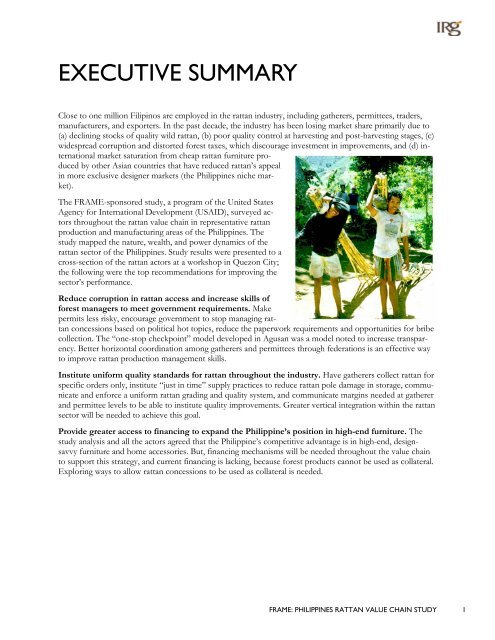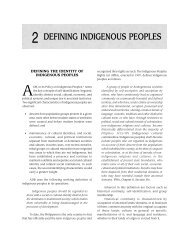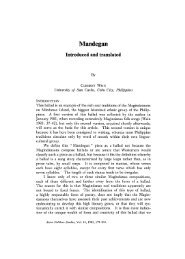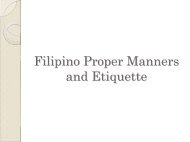EXECUTIVE SUMMARYClose to one million Filipinos are employed in the rattan industry, including gatherers, permittees, traders,manufacturers, and exporters. In the past decade, the industry has been losing market share primarily due to(a) declining stocks of quality wild rattan, (b) poor quality control at harvesting and post-harvesting stages, (c)widespread corruption and distorted forest taxes, which discourage investment in improvements, and (d) internationalmarket saturation from cheap rattan furniture producedby other Asian countries that have reduced rattan’s appealin more exclusive designer markets (the Philippines niche market).The FRAME-sponsored study, a program of the United StatesAgency for International Development (USAID), surveyed actorsthroughout the rattan value chain in representative rattanproduction and manufacturing areas of the Philippines. Thestudy mapped the nature, wealth, and power dynamics of therattan sector of the Philippines. Study results were presented to across-section of the rattan actors at a workshop in Quezon City;the following were the top recommendations for improving thesector’s performance.Reduce corruption in rattan access and increase skills offorest managers to meet government requirements. Makepermits less risky, encourage government to stop managing rattanconcessions based on political hot topics, reduce the paperwork requirements and opportunities for bribecollection. The “one-stop checkpoint” model developed in Agusan was a model noted to increase transparency.Better horizontal coordination among gatherers and permittees through federations is an effective wayto improve rattan production management skills.Institute uniform quality standards for rattan throughout the industry. Have gatherers collect rattan forspecific orders only, institute “just in time” supply practices to reduce rattan pole damage in storage, communicateand enforce a uniform rattan grading and quality system, and communicate margins needed at gathererand permittee levels to be able to institute quality improvements. Greater vertical integration within the rattansector will be needed to achieve this goal.Provide greater access to financing to expand the Philippine’s position in high-end furniture. Thestudy analysis and all the actors agreed that the Philippine’s competitive advantage is in high-end, designsavvyfurniture and home accessories. But, financing mechanisms will be needed throughout the value chainto support this strategy, and current financing is lacking, because forest products cannot be used as collateral.Exploring ways to allow rattan concessions to be used as collateral is needed.FRAME: <strong>PHILIPPINES</strong> <strong>RATTAN</strong> <strong>VALUE</strong> <strong>CHAIN</strong> <strong>STUDY</strong> 1
1. INTRODUCTION1.1 <strong>RATTAN</strong>Rattan is one of the Philippines’ most important nontimber forest products (NTFP). Rattan belongs to a largesubfamily of the climbing palms known as Calamoideae, which grows throughout the country. Mainly becauseof the strength, lightness, versatility, and pliability of its stems, rattan is widely used by furniture and handicraftindustries, making it an export winner for the country.Close to one million Filipinos are employed in the rattan industry in various capacities, mostly as gatherersand workers in furniture and handicraft sectors. For many marginalized people living in and on the fringes ofthe forest, particularly indigenous people, rattan provides cultural richness in household furnishings, buildingmaterials, and personal adornment, as well as an opportunity to earn cash. Despite the importance of rattan,the Philippine’s rattan industry is in decline. This value chain report explores the sector’s dynamics and identifiesstrategies for reversing the decline.1.2 <strong>STUDY</strong> SAMPLE, KEY VARIABLES, AND CRITERIA FORSELECTION OF SITESFRAME “Knowledge Sharing for the Natural Resource Community,” a USAID-supported program, hassponsored this value chain study for rattan. The FRAME study seeks to open up a dialogue among naturalresource managers and stakeholders within the framework of “nature” (environmental management),“wealth” (economic concerns) and “power” (good governance) to understand better the different needs andinterests of the various stakeholders involved with this very important natural product.Both primary- and secondary-level data were collected. Primary data were gathered through surveys, personalinterviews, key informant interviews, telephone inquiries, focus group discussions, participant observation,and ocular inspection. The institutions that were sources of data include:• Department of Agriculture (DA)• Department of Environment and Natural Resources (DENR) and its bureaus, such as the Forest ManagementBureau (FMB) and Ecosystems Research and Development Bureau (ERDB)• Department of Science and Technology, especially its line agency the Philippine Council for Agriculture,Forestry, and Natural Resources Research and Development (PCARRD)• Department of Trade and Industry (DTI)• National Statistics Office (NSO)• University of the Philippines Los Baños (UPLB)• USAID• Nongovernmental organizations (NGOs), such as the Enterprise Works/VITA (EWV) and Cebu FurnitureIndustries Foundation (CFIF).In addition to data collection from the groups noted above, four survey instruments were developed to facilitatedata gathering from (a) rattan gatherers, (b) kapatas/permittees, (c) traders, and (d) furniture and handicraftmanufacturers and exporters. The number of interviews conducted for the entire study was 30 (9 fromrattan gatherers, 10 from kapatas/permittees and traders, and 11 from manufacturers).There were two major groups of study sites representing both ends of the rattan marketing chain: rattan productionareas and rattan processing and manufacturing sites. The production areas were chosen to representthe three main legal tenure rights associated with rattan access, and the rattan processing and manufacturingsites were chosen based on concentration of industry members and volume of sales.2 FRAME: PHILLIPINES <strong>RATTAN</strong> <strong>VALUE</strong> <strong>CHAIN</strong> <strong>STUDY</strong>
















